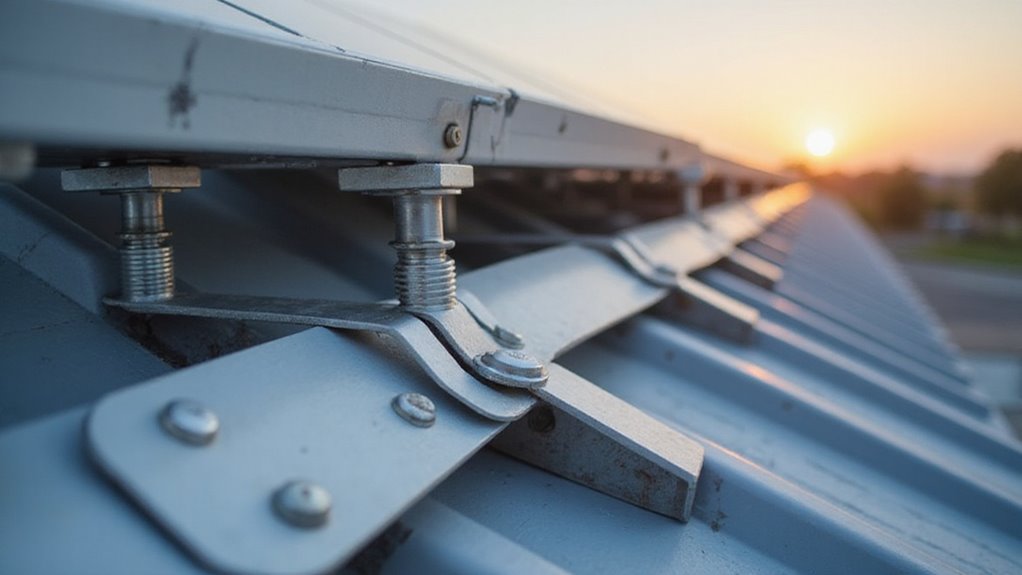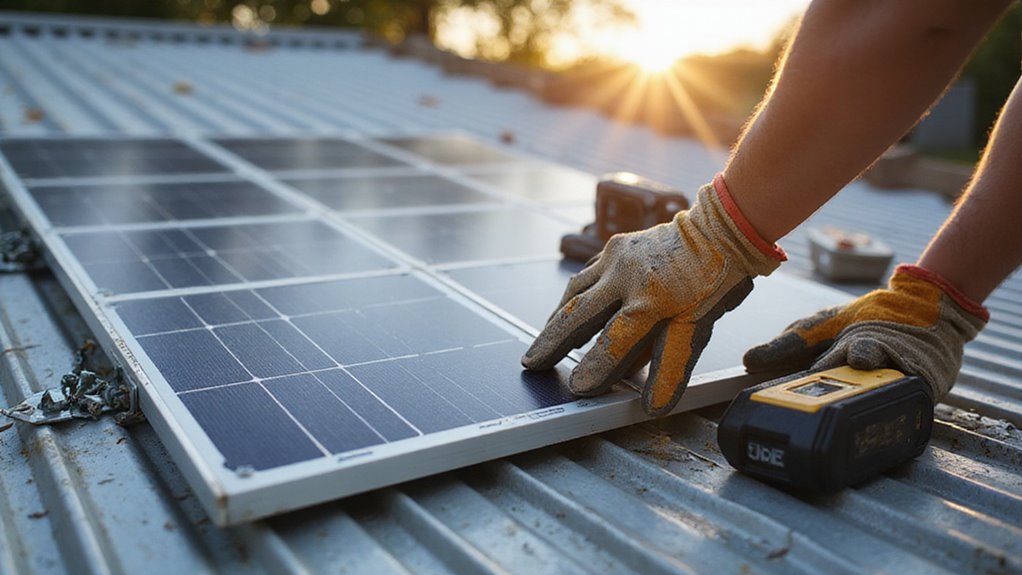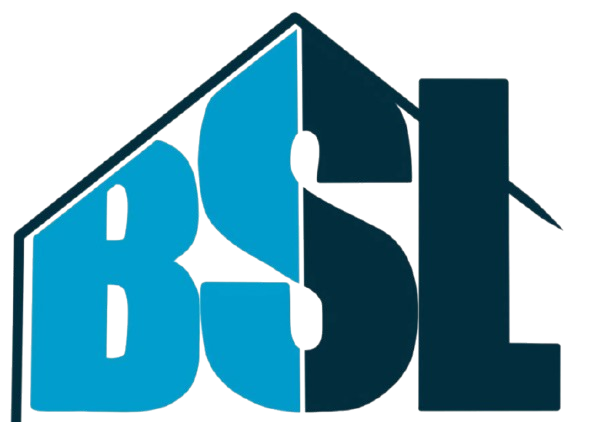Gone are the days when metal roofs limited homeowners’ clean energy options. Many property owners worry about damaging their expensive metal roofs while pursuing solar power solutions. The thought of drilling holes and compromising roof integrity keeps people from making the switch. Fortunately, modern solar mounting systems offer safe, effective installation methods for metal roofs.
Metal roofs are actually ideal candidates for solar panel installation, offering 40-70 year lifespans that outlast solar panels. Standing seam metal roofs allow non-penetrating clamps for secure mounting without compromising the roof’s integrity.
This comprehensive guide explores everything you need to know about installing solar panels on metal roofs.
Key Takeaways
- Solar panels work excellently on metal roofs, with non-penetrating clamps on standing seam designs preventing holes and water damage.
- Metal roofs last 40-70 years, outlasting solar panels’ 25-30 year lifespan, making them ideal long-term foundations.
- Installation costs range from $15,000-$30,000, with federal tax credits reducing expenses by 30% and long-term savings of $20,000-$40,000.
- Professional installation ensures proper mounting systems rated for 140+ mph winds and compliance with electrical codes and building permits.
- Metal roofs’ heat-reflective properties and structural strength enhance solar panel efficiency without requiring additional reinforcement.
Are Solar Panels Compatible with Metal Roofs?

Yes, solar panels work excellently with metal roofs. Metal roofs provide an ideal foundation for solar panel installations. Metal roofs last between 40 to 70 years, which exceeds the lifespan of most solar panels. The standing seam design allows for simple clamp attachments without making holes. These features protect against water damage and maintain roof warranties.
Moreover, metal roofs have strong structural support for solar panel weight. Professional installers can easily verify load requirements through standard calculations to meet building codes. The combination creates a durable, efficient system for sustainable energy production.
What Makes Metal Roofs Ideal for Solar Panels?
Metal roofs offer structural and environmental advantages that align with solar panel system requirements. Their durability outlasts most photovoltaic arrays by decades, while their lightweight yet load-bearing design supports mounting hardware without requiring additional reinforcement. You’ll also benefit from the combination’s eco-friendly profile and the roof’s inherent heat-reflective properties that can improve panel efficiency.
Durability and Longevity Alignment
Metal roofs and solar panels align well for maximum durability and longevity. A metal roof lasts 40 to 70 years, while solar panels typically function for 25 to 30 years. This perfect pairing prevents costly mid-system roof replacements.
As a result, property owners avoid disruptions to their energy production systems. The combined warranties provide peace of mind for long-term installations. Moreover, this stable foundation ensures reliable performance throughout the entire solar system lifecycle.
These compatible lifespans create an ideal investment opportunity with minimal maintenance concerns. Metal roofs protect solar installations effectively while delivering decades of reliable service.
Lightweight Structure Advantages
Lightweight structures offer superior weight distribution and stress management advantages. Metal roofs spread loads evenly across their support system. A typical residential solar installation adds only 2 to 4 pounds per square foot to the roof. Standing seam designs transfer weight directly to rafters without strain.
Furthermore, these structures rarely need extra reinforcement for solar installations. Local building codes still require verification through proper structural calculations. This natural strength makes lightweight structures an ideal choice for solar projects.
Eco-Friendly Combination
Solar panels and metal roofs create an eco-friendly partnership that benefits the environment. A metal roof reflects sunlight to reduce cooling needs by up to 25 percent. Solar panels on these roofs generate clean power, which cuts household carbon emissions by 4 tons per year.
Moreover, this combination offers lasting environmental advantages. Metal roofs last 40 to 70 years, which eliminates waste from frequent replacements. These systems comply with Mississippi building requirements. The result is a sustainable choice that protects the environment while meeting local standards.
Heat Reflectivity Benefits
Heat reflective surfaces reduce heat absorption and lower indoor temperatures by up to 30%. Metal roofs reflect 70% of solar energy back into the atmosphere. These surfaces prevent heat from entering buildings during hot weather. The reflective properties help maintain comfortable indoor temperatures naturally.
Heat reflection also cuts energy costs significantly. Homeowners can save up to 25% on cooling expenses annually. Additionally, reflective surfaces extend the lifespan of roofing materials by reducing thermal stress.
Furthermore, proper heat reflection enhances the efficiency of solar panels. Solar panels work best at temperatures below 85°F, delivering optimal power output.
How Do Solar Mounting Systems Work on Metal Roofs?

When you’re mounting solar panels on a metal roof, you’ll select a system based on your roof’s profile and local building codes. Standing seam roofs accept non-penetrating clamps that grip the raised ribs, while exposed fastener roofs require bracket-and-rail assemblies anchored through the panels into structural members. Each mounting method must meet wind load calculations and electrical code requirements to pass inspection and ensure safe, compliant operation.
Standing Seam Mounting Options
Standing seam metal roofs allow three main mounting options for solar panels. Non-penetrating clamps attach directly to raised seams without making holes. Rail-based systems use brackets that connect to the seams for panel attachment. Direct-mount solutions secure panels straight to clamps with minimal hardware.
The clamp method remains most popular due to its simplicity and reliability. These mounts preserve roof warranties while preventing water damage. Proper installation ensures panels stay firmly attached through severe weather.
Building codes across Mississippi approve clamp mounts without extra structural changes. This speeds up permits and reduces installation costs.
Exposed Fastener Mounting Solutions
Solar panels mount directly to exposed fastener metal roofs through specialized brackets. The brackets penetrate the roof surface to connect with structural supports underneath. Professional installation requires waterproof EPDM rubber gaskets and marine-grade sealant to prevent leaks.
Installation must follow specific guidelines for proper attachment. Brackets need precise alignment with roof ribs and rafters. Your contractor will verify structural loads meet requirements.
Because of the direct roof penetration, proper installation protects both roof warranties and system longevity. This mounting method delivers reliable solar power while maintaining roof integrity.
Bracket and Rail Systems
Bracket and rail systems need proper installation to ensure safety and longevity. Each bracket must be spaced 16 to 24 inches apart according to building codes. Correct torque prevents dangerous loosening over time.
Professional installation makes your system secure and reliable. Licensed contractors must verify load ratings of 500 pounds per bracket minimum. A certified inspection confirms proper mounting techniques.
Regular maintenance keeps your system functioning optimally for years. Annual inspections should check for rust, loose fasteners, and structural integrity. Simple upkeep prevents costly repairs or replacements down the road.
Non-Penetrating Clamp Systems
Non-penetrating clamps secure solar panels to metal roofs without making holes. The clamps attach directly to raised seams on standing seam metal roofs. A tight grip creates a waterproof seal that maintains roof warranties.
Furthermore, these systems offer key advantages for homeowners. The installation meets building codes while reducing leak risks and labor costs. The process requires no drilling or sealants. These clamps can support panels for 40 to 70 years, matching the typical lifespan of metal roofing.
How to Install Solar Panels on a Metal Roof?
You’ll need to follow a structured installation process that prioritizes structural integrity and electrical safety compliance. The sequence begins with a professional site assessment to verify your metal roof’s load capacity and electrical service compatibility, followed by selecting mounting hardware appropriate for your roof profile. Proper execution of each step—from attachment techniques through final inspection—ensures your system meets Mississippi building codes and utility interconnection standards.
Professional Site Assessment
Professional site assessments protect your solar investment through expert evaluation and planning. A qualified solar contractor must inspect your property before installation begins. The assessment covers three key areas. Your roof’s structural capacity needs verification to safely hold solar equipment weight. The electrical service panel requires testing to handle new solar circuits according to local codes.
A thorough shade analysis tracks sun exposure patterns across different seasons. This data helps position panels for maximum energy production. Safe, efficient solar systems depend on these careful preliminary checks. Proper assessment leads to reliable performance and lower maintenance costs over time.
Mounting System Selection
Mounting systems come in two main types: penetrating and non-penetrating options for metal roofs. Clamp-on systems work best for standing seam roofs by attaching to raised seams without holes. These mounts prevent leaks and maintain roof warranties. Corrugated or ribbed roofs need penetrating mounts with lag bolts through flashing assemblies.
Moreover, proper installation affects long-term performance. Each system requires specific maintenance. Regular inspections help catch potential issues early. Most importantly, the right mount choice ensures reliable energy production and roof protection.
Proper Attachment Techniques
Proper solar panel attachments require three essential steps for safety and warranty compliance. Solar installers must document exact torque measurements during mounting to maintain manufacturer warranties. Each connection point needs careful calibration and recording. Accurate documentation prevents future structural issues.
All mounting hardware must connect directly to roof trusses or rafters for maximum stability. Surface attachments to decking alone cannot withstand severe weather conditions. Strong connections ensure lasting protection.
Clear photos prove installation quality and protect both installers and homeowners. Furthermore, detailed images help with future maintenance or modifications. Professional documentation builds trust and ensures accountability.
Electrical Integration Process
Safe electrical connections require proper wiring installation between solar panels and inverters. Licensed electricians must complete all grid interconnection work according to National Electrical Code Article 690. Weatherproof conduit protects wiring from damage and ensures long-term system safety.
Two main wiring options exist for solar installations. String inverter systems reduce costs by up to 15% compared to other configurations. Microinverter setups provide individual panel monitoring and enhanced safety features. As a result, households can choose the best option for their needs and budget.
Professional installation creates reliable solar power systems that meet safety standards. These systems protect homes while delivering clean energy benefits.
Final Inspection and Testing
Final inspection verifies solar system safety and performance before activation. Three essential tests evaluate electrical safety, waterproofing integrity, and power output. Professional inspectors check maintenance access points and emergency shutdown systems.
Mississippi enforces National Electrical Code requirements for all solar installations. After testing approval, local utilities grant grid connection permission. This final step allows homeowners to start using their clean energy systems.
A successful inspection confirms proper grounding, secure seals, and optimal energy production. As a result, families receive reliable power while staying protected from hazards.
What Are the Cost Considerations?
When planning your metal roof solar installation in Mississippi, you’ll need to account for upfront system and mounting hardware costs, typically ranging from $15,000 to $25,000 for residential arrays before incentives. Your investment must factor in long-term utility savings, federal tax credits (currently 30%), and any state or utility rebates that directly offset initial expenses. Additionally, budget for periodic maintenance—including electrical inspections and panel cleaning—to ensure code compliance and system performance over the 25–30 year lifespan.
Initial Installation Investment
Initial solar panel installation costs $15,000 to $30,000 for a standard home system in Mississippi. Metal roofs offer excellent durability and value for solar installations.
Financial assistance makes the investment more manageable. The Federal Investment Tax Credit reduces costs by 26%. Mississippi residents can access net metering programs to lower utility expenses.
Metal roofs provide lasting benefits for solar projects. These durable surfaces eliminate future replacement costs during the solar system’s lifespan. Standing seam designs ensure secure, watertight installations that meet building codes.
Long-term Energy Savings
Solar panels on metal roofs deliver substantial long-term energy savings. A typical Mississippi homeowner saves $20,000 to $40,000 on electricity costs over 25 years. Metal roofs enhance solar panel performance through better ventilation and heat reflection.
Moreover, solar systems on metal roofs produce 10-15% more energy than those on asphalt shingles. The federal Investment Tax Credit reduces installation costs by 30%. Metal roofs last 40-70 years, eliminating the need for costly re-roofing during your solar system’s lifespan.
Available Tax Incentives and Rebates
Tax incentives and rebates offer substantial savings for solar installations. Homeowners can receive up to $2,500 through USDA Rural Energy grants. Net metering programs allow customers to earn credits on monthly utility bills. These credits help offset electricity costs throughout the year.
Property tax benefits exclude solar equipment from property value assessments. Metal roof installations qualify for additional tax deductions of up to 30%. As a result, homeowners save money while increasing their property value.
Furthermore, Mississippi residents can combine these incentives with federal tax credits. The Public Service Commission updates program requirements quarterly.
Maintenance Expenses
Solar panel maintenance costs range from basic to significant expenses over time. Annual panel cleaning and inspection fees typically run $150 to $300. Inverter replacement becomes necessary every 10 to 15 years, with costs between $1,000 and $2,500.
Regular upkeep ensures optimal system performance and longevity. Monthly monitoring services add $0 to $50 to maintenance budgets. Metal roof wiring upgrades can cost $200 to $800 when technical improvements become available.
These maintenance costs help prevent system failures and maintain peak energy production. Most solar companies offer service packages to spread these expenses over time.
Can DIY Installation Work on Metal Roofs?

Yes, DIY installation can work effectively on metal roofs with proper preparation and expertise. Professional guidance remains essential for safety and code compliance.
A licensed electrician must complete final grid connections and obtain necessary permits. The mounting system requires careful selection to match your specific metal roof type. Proper waterproofing techniques protect against leaks and damage.
Successful DIY projects need thorough planning and research. Furthermore, local building codes and utility requirements must be followed. Most areas mandate professional inspections before system activation can occur.
What Potential Challenges Should Homeowners Know?
Before you proceed with solar installation on your metal roof, you’ll need to address several critical challenges that impact system performance and code compliance. Weather extremes, roof structural integrity, electrical infrastructure capacity, and local permitting requirements can each halt or delay your project if not properly evaluated. Assessing these factors early ensures your installation meets Mississippi building codes and functions safely for decades.
Weather and Environmental Factors
Weather and Environmental Factors Impact Solar Panel Success Mississippi weather creates unique challenges for solar panel installations. The state receives 4.5-5 peak sun hours daily, providing excellent solar potential. Strong winds and storms demand careful planning for safety and durability.
Metal roofs need special mounting systems rated for 140+ mph winds. Proper installation prevents damage during severe weather events. A minimum 4-inch air gap maintains panel efficiency and prevents 25% performance losses from heat.
Hurricane-resistant panels must meet UL 2218 Class 4 standards for hail protection. Professional installers calculate structural requirements to ensure long-term reliability. As a result, properly mounted systems withstand Mississippi’s challenging climate conditions.
Roof Age and Condition Assessment
A professional roof assessment determines if your roof can support solar panels safely. Metal roofs have a lifespan of 40 to 70 years, while solar panels last 25 to 30 years. Your roof needs at least 25 years of remaining life before installing panels. A thorough inspection checks for rust spots and structural soundness.
As a result, Mississippi state law requires expert evaluation of roof integrity before mounting any solar system. The smart approach involves replacing older roofs first. This strategy prevents future panel removal costs and maximizes your solar investment.
Electrical System Compatibility
Solar panels and metal roofs must be electrically compatible to prevent hazards. Metal roofing requires proper grounding with dedicated electrical pathways to meet National Electric Code standards. Professional installers should verify the electrical conductivity between panels and roofing materials. A thorough electrical assessment prevents short circuits and fire risks.
For optimal safety, solar equipment needs compatible mounting systems specific to metal roofs. Local building codes mandate minimum clearances of 1.5 inches between panels and metal surfaces. This separation ensures proper airflow and reduces heat buildup.
Moreover, complete electrical isolation between mounting hardware and roof panels maintains system integrity. Regular inspections help identify potential connection problems early.
Permit and Regulation Requirements
Most Mississippi counties require building permits for solar panel installations on metal roofs. Local building departments need structural and electrical plans that follow specific codes. Homeowners must submit engineered drawings with load calculations and mounting details. These documents protect safety and ensure proper installation standards.
The Public Service Commission mandates utility agreements for grid-connected systems. Licensed electricians must verify and certify all electrical connections. Neighborhood associations might have additional rules or restrictions. As a result, homeowners should check HOA guidelines before starting any installation work.
Ready to Power Your Home with Solar? Contact BSL Roofing Today!
Contact BSL Roofing now to schedule your Professional installers transform metal roofs into solar power systems through precise mounting and electrical integration. Certified experts properly align and secure panels to maximize sun exposure and energy production. State laws require licensed professionals to handle all electrical connections and equipment installation. Your safety comes first.
Well-installed solar systems protect your roof while generating clean electricity. Proper mounting prevents leaks and maintains the metal surface integrity. A professional setup typically extends system lifespan to 25-30 years. Furthermore, expert installation ensures utility approval for grid connection. To start your solar journey, contact licensed installers who understand local codes and metal roof requirements.

